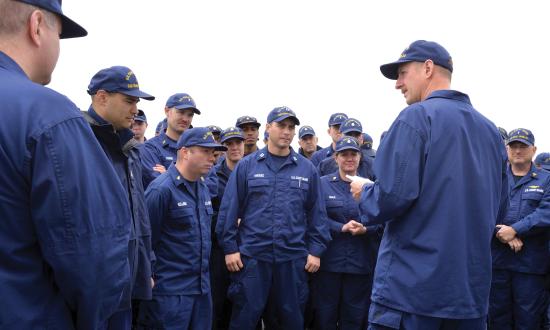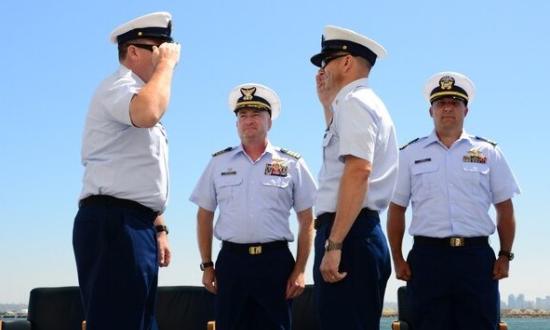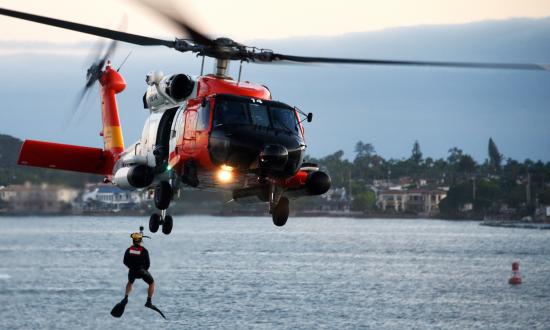Enlisted command is a longstanding reality in the Coast Guard. Since the service was established in 1915, enlisted officers-in-charge (OICs) have commanded many of its boat stations, aids-to-navigation units, and smallest cutters. With very few exceptions, enlisted OICs ranging in paygrades from E-6 to E-9 are vested by Coast Guard Regulations with the responsibilities and authorities corresponding to those of a commanding officer.1
The process to select and certify enlisted personnel for these roles has evolved over the years. Its latest iteration requires candidates sit for multiple oral boards involving many senior military personnel and civilian employees from disparate programs who ask questions on an expansive range of topics. No formal training exists to prepare candidates for these boards, and vague standards for determining their outcome leave many frustrated and others unwilling to attempt them. Such attitudes permeate to other candidates who may be especially qualified, further reducing the pool of competent and diverse applicants.
The Current Process
Under the current OIC certification framework, defined by the Coast Guard’s Military Assignments and Authorized Absences Manual, boatswain’s mates (BMs) are the only enlisted rating authorized to command the service’s many boat units and cutters. Electronics technicians (ETs) are also eligible for OIC roles and historically held these positions at Long Range Navigation (LORAN) stations, but the practice ended with the technology. To be eligible for command, BMs must first meet prerequisites and career milestones that determine the OIC certifications they are qualified to obtain. Though both afloat and ashore certifications are required for advancement to E-8, attempting the OIC boards is voluntary and begins with candidates submitting a four-part screening package favorably endorsed by their command. Candidates must certify in desired OIC competencies by passing both a sector pre-board and a district review board. Four OIC certifications may be granted by the board: multimission ashore for shore-based boat stations, multimission afloat for the smallest classes of white- hull cutters, aids-to-navigation ashore for shore-based teams, and aids-to-navigation afloat for the smallest classes of black-hull cutters. Once certified, BMs must successfully screen for an available command position during an assignment year, a process that involves a screening panel reviewing their electronically imaged service records. ETs, chief warrant officers (CWOs), and commissioned officers have no board requirement and gain command assignment through only a screening panel of their electronic personnel records.2
It is unclear why screening panels of electronic records are a viable method for selecting OICs from one enlisted rating and the officer corps, while the BM rating requires an additional battery of in-person boards. The answer may be simply one of historical precedent. When the U.S. Life-Saving Service was established, uniformed keepers of lifeboat stations working under civil service rules were subordinate to officers of the Revenue Marine assigned to inspect them. Even when the services were combined to form the Coast Guard and adopted a naval rank structure, keepers were limited to appointments as warrant officers.3 As time passed, the compensation afforded to many of the command positions at stations and aids-to-navigation units with assigned boats—now termed boat forces units—was further reduced to the senior enlisted levels. Staffing and budgetary concerns gave rise to the enlisted cutter OIC, a role primed for a steep decline as the service retires its 87-foot patrol boat fleet and procures new classes of inland river cutters that are likely to see their command roles filled by CWOs and junior officers.
Boat Forces
Despite boat forces providing the bulk of the operational statistics for the modern Coast Guard—the same statistics relied on to drive budgets and generate public support for the service—those commanding them are almost entirely enlisted, with only a handful of larger units headed by CWOs or officers with prior enlisted service. This fact negatively affects boat forces units, whose budgets, facilities, and support often pale in comparison with what other unit types receive. Prior commanding officers of air stations, major cutters, and Coast Guard sectors ascend to the highest levels of the service, where they can best advocate for their work communities. Boat stations rely more on the congressional representative in their district advocating for their needs.
For all the acclaim the BM rating enjoys from being designated a command rating, the reality is those serving in enlisted command roles are being underpaid for the value they provide the service. Boat forces are an afterthought to the veterans of cutters and aircraft who control the purse and make the policies. Sectors have created an entirely new shoreside command structure, and even an enlisted rating to support it, with the result being a confusing, dangerous parallel operational chain of command. This was done on the backs of a seemingly unaware BM rating that continues to willingly take on the responsibilities and risks for training crews and maintaining assets, only to see their authority effectively negated during operations when the sector staff—many with little or no experience on the water—assume operational control, often to the detriment of crew safety and operational efficiency.4
Remedying the Problem of Enlisted Command
Enlisted OICs now work in an environment characterized by shrinking authorities and increased sector bureaucracy, while shouldering the risks of command when convenient for sector leaders. Boat forces command positions should instead be designated at a paygrade more appropriate for their role, which would ensure veterans of such service can later advocate for the community when they reach the highest levels of leadership. These billets could easily be reprogrammed from sectors, which are nonoperational and officer-heavy.
At a minimum, the boat forces OIC certification process for BMs needs to be streamlined and made less onerous. No formal process exists to prepare candidates for the OIC board, nor to prepare board members to make truly equitable determinations on who should be vested with command.
Because they are required of only a single enlisted rating, OIC boards seem an unnecessary step in selecting personnel to fill these positions. A panel review of electronic service records would be consistent with the process used to select personnel for other special assignments and would align with the processes used to identify ETs, CWOs, and commissioned officers eligible for command.
Panel reviews also eliminate some of the more glaring concerns of subjectivity inherent in a board. Subjectivity must be avoided to the maximum extent possible to eliminate the potential for bias likely to impede the advancement of a more diverse workforce. A lack of diversity is a major problem in the BM rating, which in recent years has been subject to intense scrutiny as the service seeks ways to expand the number of women and minorities in command positions. A targeted recruiting video and campaign may succeed in getting the desired demographics to enlist and attend ‘A’ School, but a subjective board process that acts as a ceiling to advancement has negatively affected the Coast Guard’s largest rating and diversity goals for decades.
Without advances to the current enlisted command program, the boat forces community will remain without a veteran advocate at the flag level, and the BM rating will continue to lack diversity among its senior positions.
1. U.S. Coast Guard, U.S. Coast Guard Regulations, Commandant Instruction M5000.3B, 1992, 38.
2. U.S. Coast Guard, Military Assignments and Authorized Absences Manual, Commandant Instruction M1000.8A, June 2019, 1-66–1-75.
3. An Act to Create the Coast Guard by Combining Therein the Existing Life-Saving Service and Revenue Cutter Service, 28 January 1915, 800.
4. Marc Santora, “Coast Guard Vessel Capsizes During Fishing Boat Rescue Near Queens,” The New York Times, 25 February 2016.







